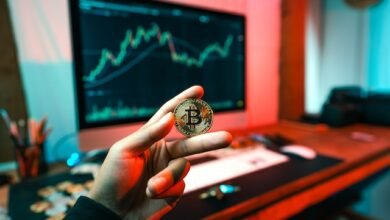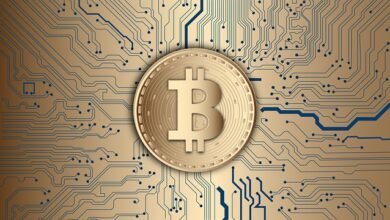Ripple – what is it and is it worth investing in XRP?

Ripple – what is it and is it worth investing in XRP?
Ripple, unlike Bitcoin, was not a new payment method, but a new payment method, and in fact a settlement system. The creators of cryptocurrency realized that the traditional financial infrastructure is inefficient and uses too many intermediaries, which, among other things, leads to long waiting times for bank transfers. As a result, they have built a modern network that many well-known institutions such as American Express , Credit Agricole, Santander and UniCredit have already joined.
Ripple, like other cryptocurrency projects, has specific functions, but at the same time it is a tool in which you can invest money. So check out how to do it and if it is worth it at all.
To better understand the process and applications of Ripple, you need to know at least a little about what cryptocurrencies are, why Bitcoin was created, and how blockchain technology works. We have discussed these issues in separate articles and among them you should start exploring the world of cryptocurrency.
Ripple – what is it and what is its purpose?
Ripple is a semi-decentralized trading network that has its own cryptocurrency and is used for real-time settlements. Its digital currency is marked with the symbol XRP, and investors often refer to it simply as Ripple, just like the network it operates on.
The Ripple platform allows banks to make settlements very cheap and fast, and also allows businesses to easily make international transfers using different currencies. It also stands out from other cryptocurrency projects in the fact that, in addition to its cryptocurrency, it also allows you to send money in traditional fiat currencies. Therefore, if the competition is for something, it is not for them, but for existing solutions approved in banks, such as the SWIFT system.
The Ripple network allows you to deal with many of the inconveniences faced by banks and their corporate and individual customers. Suffice it to say that completing an international transaction here takes only about 5 seconds, while in traditional banks – up to several days. Ripple can also act as a kind of cheap currency intermediary, thanks to which you will not have to use dollars. This is important because in the case of many currencies, the conversion with their use is associated with the charging of a double commission.
Extraordinary Ripple Operation – Central Cryptocurrency
The term “semi-decentralized” means that Ripple is not a cryptocurrency in the strict sense of the word. It does not use blockchain technology to secure network transactions (it uses its own hash tree method), and it is not traded by mining. Unlike Bitcoin, Ethereum and other typical cryptocurrencies, the main decisions regarding the project are not made by the community, but by the parent company Ripple Labs. Moreover, it also controls the “mining” of XRP, and at the same time owns several units of the currency.
It follows from the above that the ripple is centralized and resembles a company that issues shares. This was confirmed by the position of the US Securities and Exchange Commission (SEC), according to which XRP should be regulated like other securities in the US. It should be noted that the proceedings in this case have been going on for a long time and at the moment it is difficult to determine what decision it will be. One scenario assumes that Ripple enters the traditional exchange, but in this case it is not known what will happen to existing XRP holders.
Ripple (XRP) – The Most Important Technical Issues
Ripple has been officially available since 2014, and the prototype of the decentralized digital cash system on which its network is based was built as early as 2004. For the cryptocurrency market, the project is relatively old, but nonetheless remains one of the most advanced and anticipated.
The ripple platform offers high and incremental scalability (in this respect, it will likely outperform the Visa payments network over time), but it is centralized and requires the use of gateways. This means that there is no consensus on the Proof of Work or Proof of Stake that characterizes decentralized networks. Instead, we have a consensus-based connection between network gateways, and the operations are signed using elliptic curve cipher.
The high functionality and effective operation of the corrugated billing system is due to three main elements:
- xRapid – a dedicated settlement network for financial institutions, which allows instant conversion of fiat currencies using XRP as a transfer medium;
- xCurrent – a program that supports fiat currencies and ensures the operation of the network without the need to use XRP;
- xVia – a terminal for banks, thanks to which they can competently join the Ripple network.
Unlike Bitcoin and many other projects, Ripple does not have a cryptocurrency mining operation. All XRPs were created at the same time, totaling 100 billion units.
How and where to buy Ripple?
If you want to invest in Ripple, all you have to do is use cryptocurrency exchange services or cryptocurrency exchanges and buy XRP. The latter method is usually more profitable, and at the same time allows the use of many useful solutions for investors. Cryptocurrency exchanges provide, in addition to convenient trading of virtual assets, access to, among other things, price charts and a set of technical analysis tools.
Ripple is at the forefront of cryptocurrency projects in terms of capital and money turnover. However, the truth is that due to the SEC issue, it is no longer as popular as it was a few years ago, when it received the most attention, next to Bitcoin and Ethereum. In addition, it has made individual cryptocurrency exchanges decide to withdraw Ripple from their trading system. However, you can still find XRP on many investment platforms, including Binance, Huobi, Kraken, and BitBay.
You can also trade the cryptocurrency Ripple with leverage (for example on the Binance exchange), and with a multiplier of up to 75. Thanks to futures contracts, you have the opportunity to profit not only from increases but also from a decrease in the price of XRP. Remember, however, that the risk in this case is really quite high, and dynamic and high price fluctuations can drive even experienced traders out of the market.
If you want to invest in XRP with a medium or long-term perspective in mind, you should send the purchased cryptocurrency to a secure desktop, browser, or hardware wallet (eg from Ledger). For security reasons, only cryptocurrencies intended for day trading should be held by exchanges.
Ripple Cryptocurrency – Predict 2021-2024 and path behavior so far
When considering an investment in a particular project, it is worth considering the historical behavior of the cryptocurrency exchange rate . Thanks to this, you will be able to determine the level of risk and the possible profit for the planned investment.
Ripple rate (XRP), like the prices of other virtual assets, is characterized by high volatility. Suffice it to say that there were periods in the past when the cryptocurrency gained several hundred percent or lost more than half of its value in literally a few days. When it comes to the long-term trend, it must be admitted that in XRP it clearly looks less favorable than in the case of, say, Bitcoin or Ethereum.
The cryptocurrency Ripple initially cost less than a cent, and until the beginning of the boom in 2017, it saw only short-term price increases. At the time, it was just under $4, but then there were several months of declines that brought the price of XRP down to a dozen cents or so.
Looking at the chart above, it is difficult to find a permanent and long-term trend, but you can notice other interesting patterns. Well, the amazing fact is that Ripple goes through temporary price snapshots from time to time, which in a few weeks at least several times increase, and then gradually begin to decrease. On this basis, XRP can be considered a highly speculative cryptocurrency, the price of which often does not follow the broad market, unlike the prices of many other projects.
For the above reasons, it is difficult to predict the course of the wave in the coming years. The predictions for 2021 and the following years, regardless of who the author is, are burdened with very high risks, so there is no point in quoting from them. The general sentiment in the financial markets will be crucial to the price of XRP, as well as what will happen around the project and the issue related to the SEC.
Is it worth investing in Ripple?
Ripple is one of the cryptocurrency projects that has a chance to break into the mainstream and play an important role in the process of modernizing or actually transforming classical banking. It offers really interesting solutions which, over time, may turn out to be a threat to popular banking systems like SWIFT or Western Union .
However, keep in mind that the potential success of the project does not have to translate into an increase in the price of the cryptocurrency. This is because XRP is not necessary to run the Ripple network. To this must be added the fact that cryptocurrency is a complex and still highly speculative environment where project valuations are influenced by a number of, sometimes unclear, factors. It often happens that a project is developing very well, but negative sentiment in the market, poor marketing or emotional reactions of investors do not allow the price of the relevant cryptocurrency to rise.
When discussing the topic of Ripple, it is impossible not to mention what crypto enthusiasts think. Well, many of them accuse it of being too centralized, and even consider it a “banking project” that has nothing to do with traditional cryptocurrencies. Therefore, although Ripple uses technologies that are somewhat close to crypto enthusiasts, it does not share the values that are important to them. Let us add that, among other things, o the desire for independence from governments and institutions that control the financial system, as well as the possibility of conducting anonymous transactions without the participation of intermediaries.




2 Comments